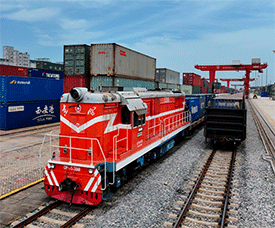China-EU railway shipping companies say trade to slowly recover after reopening of Poland-Belarus border, some planning alternatives
(Global Times/BRNN) --A number of China-EU railway shipping companies are seeing slow recovery in cargo flows after the announcement of the reopening of borders between Poland and Belarus, after a shutdown affected trade, including goods carried by the China-Europe freight train service.
It comes after Poland decided to reopen its borders with Belarus following a temporary shutdown.
Poland decided to reopen its border crossings with Belarus at midnight from Wednesday to Thursday, Polish Prime Minister Donald Tusk said, according to the Xinhua News Agency.
 |
| A China-Europe freight train leaves Lianyungang, East China’s Jiangsu Province, from the China-Kazakhstan logistics hub. |
Due to the joint military exercise Zapad-2025 held by Russia and Belarus from September 12-16, Poland closed all border crossings with Belarus from midnight on September 12, Xinhua reported.
The border closing left more than 130 China-Europe freight trains stranded on the Belarusian side at the Brest crossing, Reuters reported.
It is expected that seven to 10 days are required to clear accumulated volumes if both sides run around the clock, seven days a week, Arkadiusz Filipowski, CEO of Polish logistics firm Fulfilio Sp. z o.o., told the Global Times, adding that for prioritised and time-critical items, the delay can be cut to just one to two days.
We expect that there will be temporary low single-digit premiums while the backlog is cleared, and an extra two to five days for the transit compared with normal times. Then there will be re-stabilisation, the CEO said.
Shao Boer, general manager of Xi’an-based ITL Group, told the Global Times that the border shutdown has not impacted cargoes arriving in Russia and Belarus but greatly impeded cargoes destined for European destinations using the China-Europe Railway Express.
Shao said that, as a result of the closure, industry players have been exploring alternative routes, with one route going across the Caspian Sea and the other going intermodal through St Petersburg before goods are loaded onto ships to cross the Baltic Sea to reach European ports.
The shutdown happened as the world’s first China-Europe Arctic container express (China-Europe Arctic Express) route was recently launched, linking the Ningbo-Zhoushan Port in East China’s Zhejiang Province with the Port of Felixstowe in the UK.
Compared with the recently opened Arctic route, the China-Europe Express has a richer range of route options, and only requires forty or fifty containers to assemble and ship, which can quickly respond to the transportation needs of small and medium-sized batches of goods. The Arctic route is more suitable for large-scale, long-term transoceanic freight planning, Shao said.
However, the closure has also given customers a new understanding of the importance of diversifying transportation routes, creating certain conditions for the subsequent promotion and development of alternative routes, Shao said.
With freight trains departing every 30 minutes or less on average, the China-Europe Railway Express operates in an efficient, stable and smooth manner, not only bridging economic and trade exchanges between Asia and Europe, but also injecting forces for growth into Belt and Road Initiative participating countries, Chinese Foreign Ministry spokesperson Lin Jian told a press conference in June, commenting on data showing that the China-Europe Railway Express had operated more than 110,000 trips in total, with the value of goods shipped exceeding US$450 billion.
The China-Europe Railway Express is an epitome of connectivity cooperation between China and the wider world. From the China-Laos Railway and the new western land-sea corridor train services that are operating smoothly to the China-Kyrgyzstan-Uzbekistan railway under construction, new routes have enhanced the efficiency of cross-border logistics, enabled more personnel and trade exchanges, and deepened industrial coordination and value chain integration, driving industrial transformation and upgrading in those countries and bringing a tangible sense of gain for local people, Lin said.
(Latest Update September 26, 2025) |